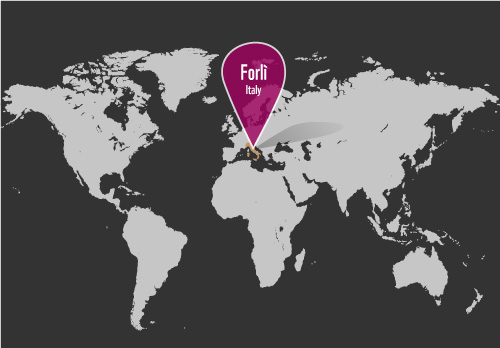The WWF is run at a local level by the following offices...
- WWF Global
- Adria
- Argentina
- Armenia
- AsiaPacific
- Australia
- Austria
- Azerbaijan
- Belgium
- Bhutan
- Bolivia
- Borneo
- Brazil
- Bulgaria
- Cambodia
- Cameroon
- Canada
- Caucasus
- Central African Republic
- Central America
- Chile
- China
- Colombia
- Croatia
- Democratic Republic of the Congo
- Denmark
- Ecuador
- European Policy Office
- Finland
FORLI

Forlì is a typical medium-sized town (116,000) in the Po River Valley in the Emilia-Romagna region. Its size means that it can serve as a strong example for other medium-sized cities because, according to the UN, it is in cities with 100,000 to 250,000 inhabitants that most of the world’s urban growth is taking place. Around half the population of Europe lives in medium-sized cities, compared with a quarter of the population who live in major cities. The vision of Forlì's Sustainable Energy Action Plan, is to manage the shift towards a carbon-free energy economy by lifestyle changes, sustainable development and planning, and a sustainable city governance. The first goal is a 25% reduction in carbon dioxide emissions by 2020, which will come from four key areas: installation of renewable energy sources (27.5%), energy efficiency (20%), efficient and sustainable services (34.5%) and a modal shift (18%).
Investments in renewables
Forlì invests in a broad range of renewable energy sources such as solar, biomass, geothermal energy and a biogas plant for biodegradable waste. Solar PVs have been installed on public buildings such as schools, kindergartens, bus terminals, and stadiums as well as on private buildings. District heating systems with renewable sources are also under development. The city has targeted energy efficiency savings from renovation of public buildings, including their heating systems, electricity and lighting; a program for urban renewal that includes support for private building retrofits; and a program for small combined heat and power plants (CHP) for apartment blocks. The city has also created incentives for private renovations through, for example, energy declaration schemes for houses.
To improve its own services, the city has been reducing waste for incineration, developing a city-wide district heating system, installing LEDs for traffic and street lighting and enlarging green areas. Improved waste management had already led to a 70% degree of waste separation in 2011. Concerning sustainable mobility, the city has developed a mobility master plan that integrates sustainable transportation, through investments in cycle lanes, bike sharing, car sharing and new bus routes.
Constraints and priorities
The city government has faced some barriers and constraints in implementing its climate action plan such as limited financial resources, weak energy management, limited knowledge of new technologies and bureaucratic procedures. Some key priorities identified by the government have been solar installations, energy reclassification of buildings, renovation of schools, improvements in waste management, development of local district heating systems, construction of cycle lanes, and more efficient and stronger communications campaigns. Forlì's government has had an ambitious outreach program, engaging schools and residents in various projects. One example is the European Green Night of Forlì, a special annual event aimed at raising awareness among citizens on energy, environment and sustainable development, with debates and workshops, presentations, art and sports performances, and tasting of organic food and "zero kilometer" products.
The metroline is intended to go into operation in 2017, and will carry 450,000 passengers per day in the first year, across 22km and 15 stations. But for reasons of cost and flexibility, twice this number are already being transported by the BRT, Metrobus-Q, which opened in 1995, and already has three lines, 37 stops, across 24km of route. Flying over, literally, these solutions is the proposed Quito Cables, which are proposed to carry 27,000 passengers per day to more outlying parts of the city that could not realistically be served by extensions of the metro or BRT systems, given the mountain geography of the city. The model for the cable-car-based extension to public transit is an also-hilly pioneer of Latin American urban sustainability, Medellín in Colombia, whose solution is called Metrocable. These solutions are supplemented by the BiciQuito system of share-bikes, which are distributed across 30 stations in the city, and have been in operation since 2012.
Want to know more about Urban solutions?
Contact Barbara Evaeus
Global Communications Manager,
WWF One Planet City Challenge
+46 70 393 9030
barbara.evaeus@wwf.se
References
Earth Hour City Challenge, People’s Choice, Forlì, http://www.ehcitychallenge.org/peopleschoice/city/forli
carbonn Cities Climate Registry, Earth Hour City Challenge, http://citiesclimateregistry.org/cities/earth-hour-city-challenge/
Municipality of Forlì, "Sustainable energy planning", http://awsassets.panda.org/downloads/ehcc_forli.pdf
The Covenant of Mayors, "The Covenant of Mayors and the energy planning in the city of Forlì", http://www.renewal-ujszilvas.eu/Events/Docs/Forli_eng.pdf
Emilia Romagna Turismo, "The European Green Night of Forlì", may 2012, http://www.emiliaromagnaturismo.com/en/events/forli-cesena/multiple-events/la-notte-verde-europea-di-forl-204/details?ID=14806&NPAGE=1&ISFREE=ON&FREEFIND=notte+verde
Text by: Martin Jacobson
Last edited: 2017-03-15


